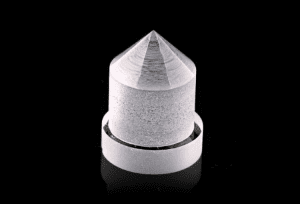Custom Axicon Lenses at Avantier
Axicon lenses are special cone-shaped optical components used as beamshapers, primarily in laser applications. At Avantier, we produce custom axicons for high performance optical assemblies.
How Axicon Lenses Work
Unlike traditional lenses, which have curved surfaces, an axicon lens features one conical surface and one planar surface. Although an axicon is used as a lens, it is in fact a rotationally symmetric prism, and can be specified by alpha angles and apex angles. For laser applications, the substrate of choice is fused silicon, but axicons can be manufactured from other optical materials as well. A planar convex axicon (positive axicon) will converge a beam of light, while a planar concave axicon (negative axicon) diverges light.
A positive axicon lens can placed with the flat (plano) surface facing a collimated light source, and the Gaussian beam will be transformed into a ring of light or (in the case of a precision axicon) an approximation of a Bessel beam. The diameter of the ring will increase as the distance between the axicon and the image increases.
To replicate a Bessel beam, the laser must be precisely aligned so that the beam travels along the optical axis. Beam expanders and optical lens mounts can help achieve the precision needed.

Applications of Axicon Lenses
Axicon lenses are often used in research, for measurement and alignment, in materials processing, and in medicine. In laser eye surgery, for example, a ring-shaped laser beam effectively smooths and vaporizes corneal tissue. To change the ring diameter, a negative and positive axicon are used as a pair with variable distance in between.
Axicons are sometimes incorporated in telescope design to increase flexibility. When an axicon is used instead of a spherical plano convex objective, the telescope can focus on targets at different distances simultaneously.
Another research application of axicon lenses is for optical tweezers and optical trapping, using the ring shape of the Bessel beam create attractive and repulsive forces that can trap, separate or move cells, molecules or atoms. For instance, the Bessel beam region (within the axicon’s depth of focus) might be used to keep particles on a microscope slide.
Axicon Lenses at Avantier
At Avantier, we are able to produce custom axicons to meet your exact specifications. Whether you need a regular axicon to create a ring shaped beam in a far field, or a precision axicon to produce a non-diffractive Bessel beam, we can manufacture the exact optic you need.
WE CAN HELP YOU!
Contact us NOW for sales & expert advice.

